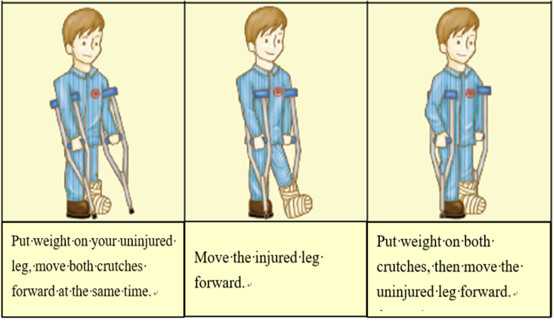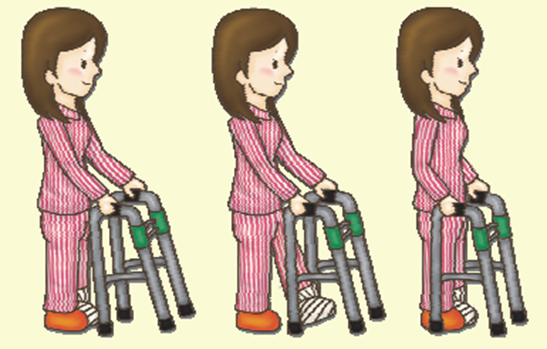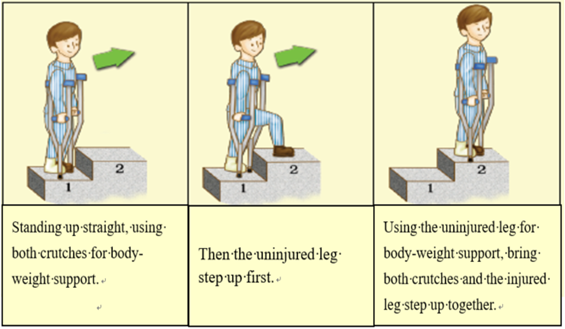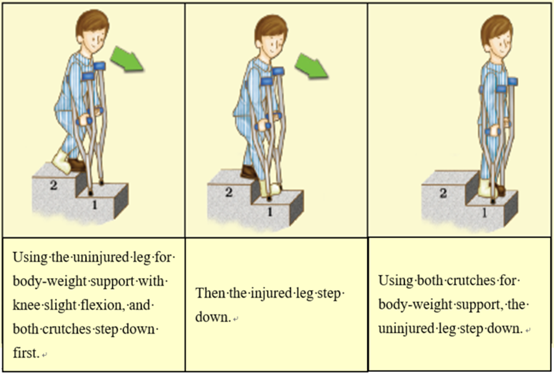【Major Points】
- Make sure your crutches have been adjusted to your height for the first time.
- Please follow the instructions and go slowly and safely to prevent falls.
- Make sure to go slowly and regain your balance before moving on to the next step.
Goals:
To limit the weight-bearing on the injured leg and improve the range of motion and self-care ability.
Crutches and walker sizing
- Crutches:
- Patients’ height subtracts 40 cm.
- The top of your crutches should be 2 finger width distance below your armpits.
- The handgrips should be adjusted to an appropriate height, in which one’s elbows are able to flex about 30 degrees when holding the handgrips.
- Walker:
The walker should be adjusted to an appropriate height, in which one’s elbows are able to flex about 20-30 degrees when holding the handle.
Gait (Three-Point Crutches Gait):
- Crutches (Figure 1):
- Put weight on the uninjured leg (healthy leg) and move both crutches forward at the same time.
- Swing the injured leg (post-surgery leg) forward.
- Put weight on both crutches and then move the uninjured leg forward.

- Walker (Figure 2):
- Place both hands on the handle, and balance yourself.
- Move the walker forward 25 to 30 cm.
- Move the injured leg (post-surgery leg) forward.
- Put weight on both hands and then move the uninjured leg forward

Going Up and Down Stairs:
- Going Up Stairs (Figure 3):
- Stand up straight and use both crutches for body-weight support.
- Use the uninjured leg (healthy leg) to step up first.
- Using the uninjured leg (healthy leg) as body-weight support, bring both crutches and the injured leg (post-surgery leg) step up together

- Going down stairs (Figure 4):
- Using the uninjured leg (healthy leg) for body-weight support with the knee slightly flexing and then allow both crutches step down first.
- Then the injured leg (post-surgery leg) step down.
- Using both crutches as body-weight support, allow the uninjured leg (healthy leg) to step down.

Caution:
- When you are the first time to use the crutches or walkers, your nurse will adjust the crutches or walkers to an appropriate height and assist and teach you.
- Before getting out of bed and walking, please make sure “person” material and environment are ready.
- Person: wear well-fitted pants and good walking shoes to prevent a fall.
- When walking with both crutches, the rubber pads should be attached properly at the bottom, and you should check them regularly. You must check the screws and rubber mat and make sure the crutches are sturdy before beginning any walk.
- Be aware of the surface on which you are walking. It should be clean, flat, and dry, in order to prevent a fall.
- Please pay attention to the following when walking.
- Stand steadily before you walk and take small steps to walk.
- Use hands and arms as body-weight support during standing. To avoid brachial plexus compression, adjust the proper height of the crutches. The height of the crutches should be below your armpits by about two fingers’ width. Keep the crutches about 10 cm out from the anterior aspect of your feet when you are standing up.
- Look straight ahead when walking, rather than down at your feet. Each step should be equal. You should not jump when using crutches.
- According to your physical condition, the level of activity can be increased gradually when you walk with crutches.
- Improper use of auxiliary tools may cause a fall, damage the brachial plexus, and/or affect the recovery of the injured leg. Follow the nurse's instructions to use the auxiliary tools.
- To avoid sand or stone attachment, keep the crutches clean and in shape.
- You can lift sandbags or do push-ups every day to strengthen the muscles of your upper extremities.
Reference
- DENG, C., Lee, S. C., Yuan, K.H., & Wu, Y. P.(2018) Musculoskeletal system diseases and nursing. In Lin, K. M (Eds.), medical - surgical nursing skills and techniques(9nd ed., pp. 477-483). Farseeing Publishing Group.
- Rasouli, F., & Reed, K. B. (2019). Walking Assistance Using Crutches: A State of the Art Review.Journal of Biomechanics, 109489. https://doi.org/10.1016/j.jbiomech.2019.109489
- Wang, K. Y., Chen, S., & Lin, L. H.,(2018). Musculoskeletal system diseases and nursing. In Wang, K. Y., Liu, H.E., & Feng, R.F(Eds.), medical - surgical nursing (5nd ed., pp. 31-36). YEONG DAH Publishing.
- Warees, W. M., Clayton, L., & Slane, M. (2021). Crutches. UpToDate. Retrieved Mar 01, 2022., https://www.uptodate.com/contents/using-crutches-the-basics?search=%20Crutches&source=search_result&selectedTitle=1~86&usage_type=default&display_rank=1
Quiz
Please answer the following questions:
Nursing Instruction Satisfaction
Please log in to rate
- Location
-
- Category
- Self-care / Home Care

